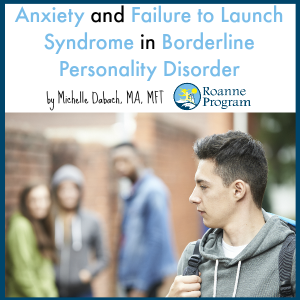Anxiety and Failure to Launch Syndrome in Borderline Personality Disorder
 Originally thought to be at the “borderline” between psychosis and neurosis, people with Borderline Personality Disorder suffer from a disorder of emotion regulation. A person with BPD may experience intense bouts of anger, depression, and anxiety that may last only hours, or at most a day. These may be associated with episodes of impulsive aggression and/or self-injury including cutting, and drug or alcohol abuse.
Originally thought to be at the “borderline” between psychosis and neurosis, people with Borderline Personality Disorder suffer from a disorder of emotion regulation. A person with BPD may experience intense bouts of anger, depression, and anxiety that may last only hours, or at most a day. These may be associated with episodes of impulsive aggression and/or self-injury including cutting, and drug or alcohol abuse.
Distortions in cognition and a lack of a sense of self can lead to frequent changes in long-term goals, career plans, jobs, friendships, and values. Sometimes people with BPD view themselves as fundamentally bad or unworthy. They may feel unfairly misunderstood or mistreated, bored, empty, and have little idea who they are.
Such symptoms are most acute when these young adults feel isolated and lacking in social support and may result in frantic efforts to avoid being alone. Having Borderline Personality Disorder is tough enough, but couple that with intense anxiety symptoms, and it’s a whole new ballgame.
Over 90% of young adults suffering from BPD experience moderate to severe symptoms of anxiety, especially at times of stress. This is a disorder based on severe fluctuations of extremely powerful moods and emotions. Often, the person switches between negative emotions and anxiety, though the anxiety is almost always present.
The emotion of anxiety can be so overwhelming, frightening, and feel so urgent. We can be tricked into believing we are going crazy, losing our minds, or that we will never know what it is like to feel calm again. In the midst of [an anxiety attack], it feels as if it is going to last forever — like there is no relief or end in sight.
~Debbie Corso, Blogger in Recovery from BPD, www.healingfromBPD.com
Anxiety can manifest in various ways, with one developing abrupt symptoms such as palpitations, sweating, trembling/shaking, shortness of breath, chest pain/discomfort, nausea, feeling dizzy/lightheaded, numbness, and/or chills or hot flashes. Symptoms are most acute when one feels isolated and/or lacking in social support.
My significant other recently got on a plane to visit his family and do business in England. For a whole month. I have known about this planned trip for about a half a year, and I was doing pretty well with it all up until a few days before he actually left. At that time, I began to notice an increase in my usual frequency of nightmares. I was waking up all hours of the night with panic attacks: heart and mind racing, sweating, feeling cold, having diarrhea — the whole kit and caboodle.
~Debbie Corso, Blogger in Recovery from BPD, www.healingfromBPD.com
Treatment
Certain types of medication may be beneficial and should be explored with one’s psychiatrist. Biofeedback, which we offer in-house in our OPI Intensive for young adults with BPD is another recommended course of therapy to assist with symptoms of BPD and anxiety. However, the most effective treatment is a combination Dialectical Behavior Therapy (DBT), which OPI Intensive is built upon, in conjunction with any recommended medications.
In the 1980s, Dr. Marsha Linehan of Behavioral Tech developed a treatment modality called DBT – a specific type of cognitive-behavioral therapy that emphasizes the psychosocial aspects of treatment. It is a method for teaching skills that help with coping with the intense and sudden surges of emotion characterized by young adults suffering from BPD.
DBT is support-oriented, cognitive based, and collaborative. There are four modules: Mindfulness, Interpersonal Effectiveness, Distress Tolerance, and Emotion Regulation.
Mindfulness teaches how to be present in the here and now; how to observe, describe, and participate. It concentrates on being present non-judgmentally, one-mindfully, and effectively.
Interpersonal Effectiveness includes teaching effective strategies for asking what one needs, saying “no,” and coping with interpersonal conflict. Distress Tolerance focuses on acceptance, finding meaning for one’s pain, and tolerating distress.
Emotion Regulation teaches skills for regulating emotions through various self-care techniques, including tending to physical wellness.
DBT helps with identifying one’s strengths, thoughts, feelings, beliefs, and assumptions. It encourages one to work out problems in his or her relationships while working with a trusted therapist. For the most benefit, it requires homework completion, such as practicing skills working on self-regulation or decreasing and dealing with stress responses. DBT is largely integrated into our OPI Intensive, and we see incredible results in our participants who learn and practice these skills.
At OPI Intensive, we offer compassionate, clinically sophisticated intensive residential help for young adult men and women who suffer from borderline personality disorder or BPD traits, including genetic testing to determine the best course for medications, if needed. Rather than a sterile, hospital-like environment, we offer beautiful accommodations in luxury apartments just outside of Los Angeles. At OPI Intensive, we treat the individual, not the diagnosis. Our clinical team is made up of a diverse community of passionate, highly skilled individuals working together with you to help you find your joy and express it. For more information on OPI Intensive residential programs and our measures to help young adults with Borderline Personality Disorder, call us at 866-661-3982 or click HERE to submit an online form. We’ll be in touch promptly.
Article References: Healing From BPD, BPD Demystified. Calm Clinic, BPD Central, Anxiety Zone, Psych Central
